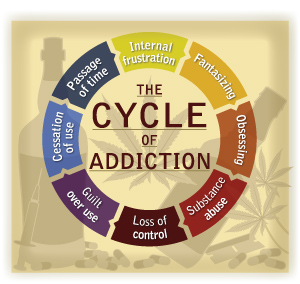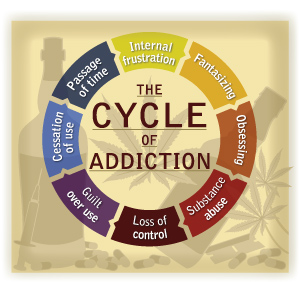This decision is much easier to make when you’re getting input from a trusted source. At CCCADA, we understand that the most important part of choosing a rehab center is finding the place that meets the individual’s every need. Call us today to speak directly with a trained addiction treatment specialist: (866) 781-3882.
The cycle of addiction is created by changes produced in brain chemistry from substance abuse. It is perpetuated by physiological, psychological and emotional dependency. This cycle of addiction continues unrestrained, until some type of intervention occurs (self-intervention, legal, family, etc.).
What Is the Cycle of Addiction?

Cycle of Addiction
Drug and alcohol addiction research has clearly demonstrated that the addicted brain is chemically and physiologically different from a normal brain. The idea of addiction being a neurological disorder is critical to understanding its development and the recovery process.
Eventually, from internal turmoil and conflict or through outside interventions, a person can try to stop the addiction cycle and enter a healthier lifestyle called recovery. It may take months, years or decades before this process leads one to the path of recovery. An addict or alcoholic may understand the cycle of addiction, but will remain unable to break the repetition of the cycle until they develop the insight to seek help.
For some, entry into a religious organization, self-help group or simply developing a better way of life can help. However, the vast majority of addicts require outside help from counselors, physicians and drug and alcohol rehabs.
ddiction Defined
Addiction is defined as obsessive thinking and compulsive need for drugs, alcohol, food, sex or anything despite the resulting negative consequences. Addiction includes the development of tolerance combined with withdrawal symptoms. In addition to tolerance, an addict or alcoholic will experience intense physical cravings for the drug and an emotional obsession to take alcohol or drugs regardless of the consequences. Addiction develops over time and usually begins with misuse, moving toward abuse and resulting in addiction.
Misuse
To alleviate emotional or physical pain, a person might experiment with drugs or alcohol. Alternatively, one may use drugs or alcohol in a social setting, and decide to try them again just to have fun. Relieved of feelings of discomfort, the person will continue to use drugs or alcohol a second time, a third time and so on.Abuse
Soon the person increases use to maintain the desired effects of euphoria and escape from reality. The original problems are left unattended and/or unresolved. If the person didn’t have problems at the onset of use, problems have now been created as a result of the use. Constant attempts to satisfy the body’s cravings for drugs or alcohol become the person’s new reality.Addiction
Great time and effort is spent acquiring the alcohol or drugs. After the addict or alcoholic is completely entrenched in the cycle of addiction, the health, financial, social and emotional consequences appear. The addict may just feel that they have been unlucky, or blame the consequences on others instead of their addiction.
Drug Addiction and Alcohol Effects on the Brain
Drug and alcohol use alters the way the brain and certain neurotransmitters function. These changes in brain chemistry create addiction, tolerance and withdrawal symptoms, which all lead to cravings.
The neurotransmitters serotonin and dopamine send messages to the brain and the rest of the body. The altered brain chemistry essentially requires constant, repetitive exposure to the substance or action to function psychologically and physiologically. This chemical dependence leads to tolerance and withdrawal symptoms, two of the hallmarks of substance abuse addiction that most often require a professionally monitored alcohol and drug detox.
Addiction alters the brain chemistry affecting the process of thought and decision-making. The definition of addiction also includes strong references to denial, minimization and justification, all of which are primitive internal defense mechanisms. After the addiction is acknowledged, the addict may ultimately be forced to decide to stop using chemicals, thus breaking the cycle of addiction. The abnormal, addicted brain cannot tolerate that decision. The cycle of addiction is powerful, usually requiring outside interventions that include alcohol detox or drug detox and substance abuse treatment.
The Cycle of Addiction
The Cycle of Addiction Is Characterized By:
Frustration and internal pain that leads to anxiety and a demand for relief of these symptomsFantasizing about using alcohol and drugs or behaviors to relieve the uncomfortable symptomsObsessing about using drugs and alcohol and how his or her life will be after the use of substancesEngaging in the addictive activity, such as using substances to gain relief (acting out)Losing control over the behaviorDeveloping feelings of remorse, guilt and shame, which lead to feelings of dissatisfactionMaking a promise or resolve to oneself to stop the behavior or substance use
After a period of time, the pain returns, and the addict begins to experience the fantasies of using substances again.
This cycle can rotate on a variable basis. For example, binge users rotate through this cycle more slowly. Daily users may rotate through the cycle of addiction daily or several times throughout the day. This cycle can be arrested at any point after the addict or alcoholic makes a decision or is forced to get help. Sometimes, the consequences that arise (legal, financial, medical or social) force the addict or alcoholic to stop using. However, in the absence of outside help, such as alcohol or drug detox followed by addiction treatment help, the substance abuse or addictive behavior is likely to return.
Breaking the Cycle of Addiction
The stages of the cycle of addiction can be matched up with some of the stages of the model of behavior change and its relationship to recovery.
Precontemplation -The addict has not yet considered stopping the behavior or use of substances.Contemplation – The addict is starting to consider making a change in behavior.Preparation – The addict is mentally and, possibly, physically preparing to make a change.Action – The addict has taken an action, such as seeking treatment, self-help groups or counseling. Treatment has been provided and the addict has stopped using.Maintenance – The addict is maintaining his or her new lifestyle and behavior, following a recovery program
Unfortunately, relapse can occur during the action or maintenance stage, which means the addict or alcoholic again enters the cycle of addiction.
The Drug Personality
The drug personality develops though continued, chronic use. There is a typical set of behaviors that most addicts or alcoholics exhibit. When taken as a whole, the following symptoms are strong indicators of addiction.
A Drug Personality May:
Have mood swingsBe unreliableBe unable to finish projectsHave unexpressed resentmentBe dishonest and lie to family, friends and employersIsolate and withdraw from loved onesAppear chronically depressedBegin stealing from family and friendsEngage in risky sexual behaviorExhibit strong, primitive defense mechanisms (denial, rationalization, minimization, projection, justification, blaming)Have difficulty paying billsHave difficulty with interpersonal relationshipsHave difficulty with work relationships or is unable to hold a jobEngage in illegal or immoral activities to obtain drugs
Substance Abuse Treatment Programs Help Break the Cycle of Addiction
Some substance abuse treatment programs focus mainly on spiritual talk therapy but without tackling the disease’s underlying physiology. Quality addiction treatment programs focus on correcting the neurological imbalances caused by substance dependence. Psychosocial counseling, addiction education, and a variety of therapies, counseling, relapse prevention and aftercare plans empower the patient with the tools to stay on the road to recovery.
The post Explaining the Cycle of Addiction appeared first on Recovery Connection.

